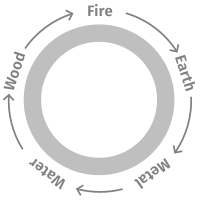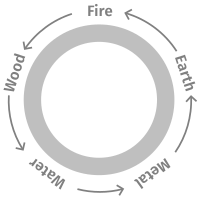The elemental approach in chinese martial arts encloses five elements – 木 (Wood), 火 (Fire), 土 (Earth), 金 (Metal), and 水 (Water) – each of them associated with specific qualities. While this very old doctrine (›Wuxing‹ — first recorded around 300 BC) is inherently unscientific in western sense, it proves practical in conceptualizing principles of movement, attack, and defense in Iaido.
Assignment to Kata
Speculatively, one could associate elemental properties to Iaido kata (in the internal Chinese martial art of Hsing-I, for instance, there are explicit forms that form the basis) or identify inherent characteristics.
- Jin (金 – Metal): Metal is linked with precision and clarity. Movements are often sharp, direct, and efficient. As the predominant material of our tool, the sword, it is an inherent element in all forms and embodies this martial art. A specific kata cannot symbolize this.
- Mu (木 – Wood): Wood represents growth and expansion. Movements are often linear, ascending, and energetic. Growth and expansion manifest in the sequence of a form. From the restful state of an Iaido kata emerges an idea and thereby the appropriate action. The Kata Gyakuto from Omori Ryu illustrates this especially.
- Huo (火 – Fire): Fire symbolizes energy, dynamism, and speed. Techniques can be fast, impulsive, and powerful. The Shihogiri form from Okuden characterizes the annihilating destructive force of fire.
- Tu (土 – Earth): Earth symbolizes stability and balance. Combat techniques focus on stability, equilibrium, and grounding. Whether the Mae Kata of Seitei Iai embodies this property can be experienced by everyone.
- Shui (水 – Water): Water represents flexibility and adaptability. Martial art movements can be flowing, circular, and smooth. The Ukenagashi form of Seitei Iai contains the liquid (passive) adaptability of water in a sliding motion.
Phases of Change
The doctrine of the five elements includes two cycles, the five phases of transformation, concerning genesis and demise.
Growth Cycle, Sheng 生
 It describes the interaction between the elements and how they influence each other. In the growth cycle, each element promotes the growth of the next. For example, wood promotes the growth of fire, as fire burns wood, providing nutrients for the earth. Earth, in turn, nurtures metal by providing minerals from which metals are extracted. Metal melts and becomes water, and water, in turn, nurtures wood by watering plants.
It describes the interaction between the elements and how they influence each other. In the growth cycle, each element promotes the growth of the next. For example, wood promotes the growth of fire, as fire burns wood, providing nutrients for the earth. Earth, in turn, nurtures metal by providing minerals from which metals are extracted. Metal melts and becomes water, and water, in turn, nurtures wood by watering plants.
What seems interesting to me when practicing Iaido is how the images can be metaphorically related to the practice itself. ›Wood energy‹, i.e. the clear, consistent execution of a kata in expansion, promotes ›fire‹, i.e. strong energy. The katana (›metal‹) is charged with this energy – but only if the earth element, the roots, are right.
Therefore, powerful training and physical strength alone are not enough to become successful. An example for practice? Check for angularity in the sequence of techniques (e.g. Chiburi, Furikaburi. This is generally more inefficient than soft movements. However, if the inherent power, the vector of movement, is lost, the soft is too weak.
Annihilation cycle, Ke 克
 This cycle describes how the elements control or inhibit each other. In this cycle, each element weakens the next. For example, fire extinguishes wood because fire burns wood. Wood, in turn, absorbs water. Finally, water corrodes metal. Metal plows the earth. Earth suffocates fire.
This cycle describes how the elements control or inhibit each other. In this cycle, each element weakens the next. For example, fire extinguishes wood because fire burns wood. Wood, in turn, absorbs water. Finally, water corrodes metal. Metal plows the earth. Earth suffocates fire.
Conclusion
These cycles metaphysically explain phases of transformation, or rather possibilities, and thus an assumed balance in nature in motion (Panta rhei = everything flows). This perception is acknowledged as a universal principle even today. Hence, the Chinese have created models for many aspects of life, but this goes beyond our scope here. What’s essential is the recognition of different energy states and their interrelationships, which provide intriguing explanatory patterns for the field of martial arts.
